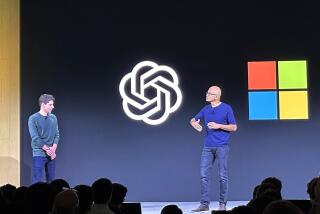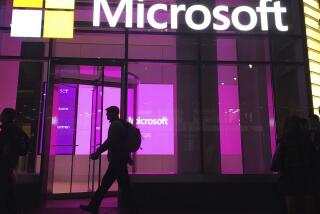Microsoft Evidence May Help Oracle
SAN FRANCISCO â A senior Microsoft Corp. executive testified in the Oracle Corp. antitrust trial Wednesday that the worldâs biggest software maker never had plans to sell sophisticated business software to big companies. But documents unsealed in court showed that Microsoft saw Oracleâs $7.7-billion bid for PeopleSoft Inc. as a strategic threat to its business.
E-mail messages and other documents revealed that Microsoft feared IBM Corp. might buy the leading business-software firm, SAP of Germany, to counteract a potential Oracle-PeopleSoft combination. That concern spurred Microsoft as it conducted its own merger talks with SAP, negotiations that came to light earlier in the trial.
âWe should think proactively in determining our fate, as no doubt the folks in Armonk are doing,â Microsoft strategist Cindy Bates wrote in an analysis for Microsoft Chief Executive Steve Ballmer, Chairman Bill Gates and others in June 2003. (IBM is based in Armonk, N.Y.)
A Microsoft bid for SAP could âpreempt tightened relations between Sagittarius and Indus,â the analysis said, using code words to identify SAP and IBM.
Microsoft was convinced that IBM was concerned -- as Microsoft was -- that there would be ripple effects if the market for the most powerful business software narrowed with the PeopleSoft acquisition to just SAP and Oracle, the documents indicate.
For starters, the underlying market for database software, on which the business programs depend, could be changed. IBM and Oracle are the two largest database makers, and Microsoft has been gaining ground with its own offering.
IBM declined to comment on any interest it might have in SAP.
The government is trying to block Oracleâs tender offer for Pleasanton, Calif.-based PeopleSoft on the grounds that if it succeeds, only Oracle and SAP would be able to supply human-resources and financial software to the largest companies. Oracle, based in Redwood City, Calif., contends that the market is actually much broader and includes Microsoft and a host of specialty firms that sell mainly to mid-sized companies but also compete for the largest business customers.
Microsoft has been a specter throughout the trial before U.S. District Judge Vaughn Walker, but Microsoft Senior Vice President Doug Burgum was the first executive from the software powerhouse to take the stand.
Burgum, who heads Microsoftâs business software division, was called by the prosecution. He testified that Microsoft was under pressure to sell financial software to smaller businesses, not larger ones, suggesting that Microsoft doesnât compete head-on with Oracle, PeopleSoft and SAP. Whatâs more, a revamp of Microsoftâs business software product line isnât likely before 2008.
âItâs not trueâ that Microsoft intends to move into the big-customer area, Burgum said. Sales to such customers involve âlong negotiations, lots of after-sale relations,â he said. âMicrosoftâs strength is low-price, high-volume packaged software. The two are very different.â
Burgum is expected to be cross-examined today about the documents relating to Microsoftâs apparent interest in SAP and worries about IBM.
Earlier Wednesday, an SAP executive called as a witness by Oracle testified that he believed an Oracle-PeopleSoft combination would probably increase competition rather than reduce it because Oracleâs sales force would be willing to cut prices to maintain its newly expanded market share.
âThey would do anything to keep that position,â said Richard Knowles, vice president of North American operations at SAP America. âOur intelligence tells us thatâs going to create a highly more competitive market.â
SAP says it is neutral in the lawsuit, and company executives have said they have no objection to it. Justice Department trial attorney Claude Scott pointed out that Knowlesâ superiors have endorsed the merger with officials of the European Union, which is still reviewing Oracleâs bid. If it were to go through, the number of SAPâs rivals would be reduced from two to one, the Justice Department says.
Knowles said SAP sometimes found itself in competition with both Microsoft and Lawson Software Inc., bolstering Oracleâs argument that the competitive landscape isnât as limited as the Justice Department maintains.
Justice Department official Thomas Barnett countered that the views of customers about the likely effect of the proposed deal should carry more weight than the words of a competitor.
âThey would prefer to have three choices,â Barnett said during a break in the proceedings.
Knowles also testified that SAP was paying close attention to Microsoftâs increasing role in the market for business software. One e-mail sent to Knowles by his boss passed along word of a 41% jump in Microsoftâs business-software revenue during one quarter.
âThese guyâs [sic] are here!â the head of SAP America said in an e-mail.
In a competitive analysis prepared after the second quarter of 2003, SAP executives concluded that they were confronting Microsoft more and more frequently.
âThe Microsoft warning signs should be taken very seriously,â the analysis concluded.
Asked to elaborate, Knowles said: âIt was our estimation that Microsoft was beginning to come up-market.â He said SAP bumped into Microsoft while competing for business with companies with as much as $350 million in annual revenue.
Other internal documents submitted in court showed SAP believes it had 54% of the market, whereas a combined Oracle and PeopleSoft would have 25%.
More to Read
Inside the business of entertainment
The Wide Shot brings you news, analysis and insights on everything from streaming wars to production â and what it all means for the future.
You may occasionally receive promotional content from the Los Angeles Times.










